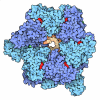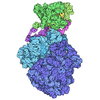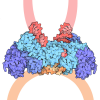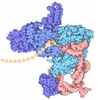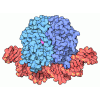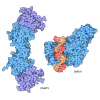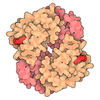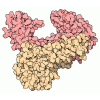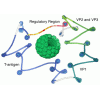+ Open data
Open data
- Basic information
Basic information
| Entry | Database: PDB / ID: 9l1x | |||||||||||||||||||||||||||||||||
|---|---|---|---|---|---|---|---|---|---|---|---|---|---|---|---|---|---|---|---|---|---|---|---|---|---|---|---|---|---|---|---|---|---|---|
| Title | hDEK-nucleosome complex (conformation 1) | |||||||||||||||||||||||||||||||||
 Components Components |
| |||||||||||||||||||||||||||||||||
 Keywords Keywords | GENE REGULATION / nucleosome complex | |||||||||||||||||||||||||||||||||
| Function / homology |  Function and homology information Function and homology informationcontractile muscle fiber / regulation of double-strand break repair via nonhomologous end joining / Transcriptional regulation by the AP-2 (TFAP2) family of transcription factors / negative regulation of chromosome condensation / Barr body / : / B-WICH complex / pericentric heterochromatin formation / inner kinetochore / muscle cell differentiation ...contractile muscle fiber / regulation of double-strand break repair via nonhomologous end joining / Transcriptional regulation by the AP-2 (TFAP2) family of transcription factors / negative regulation of chromosome condensation / Barr body / : / B-WICH complex / pericentric heterochromatin formation / inner kinetochore / muscle cell differentiation / regulation of double-strand break repair / oocyte maturation / positive regulation of transcription by RNA polymerase III / nucleosomal DNA binding / nucleus organization / positive regulation of transcription by RNA polymerase I / spermatid development / negative regulation of tumor necrosis factor-mediated signaling pathway / single fertilization / subtelomeric heterochromatin formation / RNA polymerase II core promoter sequence-specific DNA binding / negative regulation of megakaryocyte differentiation / protein localization to CENP-A containing chromatin / Replacement of protamines by nucleosomes in the male pronucleus / CENP-A containing nucleosome / Packaging Of Telomere Ends / Recognition and association of DNA glycosylase with site containing an affected purine / Cleavage of the damaged purine / embryo implantation / Deposition of new CENPA-containing nucleosomes at the centromere / telomere organization / Recognition and association of DNA glycosylase with site containing an affected pyrimidine / Cleavage of the damaged pyrimidine / RNA Polymerase I Promoter Opening / Inhibition of DNA recombination at telomere / Assembly of the ORC complex at the origin of replication / Meiotic synapsis / viral genome replication / SUMOylation of chromatin organization proteins / Regulation of endogenous retroelements by the Human Silencing Hub (HUSH) complex / DNA methylation / Condensation of Prophase Chromosomes / Chromatin modifications during the maternal to zygotic transition (MZT) / SIRT1 negatively regulates rRNA expression / HCMV Late Events / ERCC6 (CSB) and EHMT2 (G9a) positively regulate rRNA expression / PRC2 methylates histones and DNA / innate immune response in mucosa / Regulation of endogenous retroelements by KRAB-ZFP proteins / Defective pyroptosis / HDACs deacetylate histones / Regulation of endogenous retroelements by Piwi-interacting RNAs (piRNAs) / Nonhomologous End-Joining (NHEJ) / RNA Polymerase I Promoter Escape / lipopolysaccharide binding / Transcriptional regulation by small RNAs / Formation of the beta-catenin:TCF transactivating complex / Activated PKN1 stimulates transcription of AR (androgen receptor) regulated genes KLK2 and KLK3 / RUNX1 regulates genes involved in megakaryocyte differentiation and platelet function / HDMs demethylate histones / G2/M DNA damage checkpoint / NoRC negatively regulates rRNA expression / B-WICH complex positively regulates rRNA expression / PKMTs methylate histone lysines / DNA Damage/Telomere Stress Induced Senescence / Pre-NOTCH Transcription and Translation / Meiotic recombination / male gonad development / multicellular organism growth / Metalloprotease DUBs / Activation of anterior HOX genes in hindbrain development during early embryogenesis / RMTs methylate histone arginines / Transcriptional regulation of granulopoiesis / HCMV Early Events / antimicrobial humoral immune response mediated by antimicrobial peptide / osteoblast differentiation / structural constituent of chromatin / UCH proteinases / antibacterial humoral response / heterochromatin formation / nucleosome / nucleosome assembly / E3 ubiquitin ligases ubiquitinate target proteins / Recruitment and ATM-mediated phosphorylation of repair and signaling proteins at DNA double strand breaks / HATs acetylate histones / RUNX1 regulates transcription of genes involved in differentiation of HSCs / Factors involved in megakaryocyte development and platelet production / MLL4 and MLL3 complexes regulate expression of PPARG target genes in adipogenesis and hepatic steatosis / chromatin organization / Processing of DNA double-strand break ends / positive regulation of cell growth / Senescence-Associated Secretory Phenotype (SASP) / histone binding / Oxidative Stress Induced Senescence / defense response to Gram-negative bacterium / killing of cells of another organism / Estrogen-dependent gene expression / transcription by RNA polymerase II / chromosome, telomeric region / cell population proliferation Similarity search - Function | |||||||||||||||||||||||||||||||||
| Biological species |  Homo sapiens (human) Homo sapiens (human) | |||||||||||||||||||||||||||||||||
| Method | ELECTRON MICROSCOPY / single particle reconstruction / cryo EM / Resolution: 2.69 Å | |||||||||||||||||||||||||||||||||
 Authors Authors | Liu, Y. / Wang, C. / Huang, H. | |||||||||||||||||||||||||||||||||
| Funding support |  China, 1items China, 1items
| |||||||||||||||||||||||||||||||||
 Citation Citation |  Journal: Nat Struct Mol Biol / Year: 2025 Journal: Nat Struct Mol Biol / Year: 2025Title: DEK-nucleosome structure shows DEK modulates H3K27me3 and stem cell fate. Authors: Yunfan Shen / Yanhong Liu / Maochao Guo / Song Mao / Rui Chen / Mengran Wang / Zhengbo Li / Yue Li / Wan Chen / Fang Chen / Baixing Wu / Chongyuan Wang / Wei Chen / Huanhuan Cui / Kai Yuan / Hongda Huang /  Abstract: DEK is a highly conserved chromatin-associated oncoprotein that has important roles in regulating chromatin dynamics and stem cell fate. Dysregulation of DEK is associated with stem cell dysfunction ...DEK is a highly conserved chromatin-associated oncoprotein that has important roles in regulating chromatin dynamics and stem cell fate. Dysregulation of DEK is associated with stem cell dysfunction and cancers, including acute myeloid leukemia. Despite its importance in chromatin regulation, the structural mechanisms underlying DEK's interaction with chromatin and its influence on gene regulation remain poorly understood. Here we combined cryogenic electron microscopy (cryo-EM), biochemical and cellular approaches to investigate the molecular mechanisms and functional importance of DEK's interaction with chromatin. Our cryo-EM structures reveal the structural basis of the DEK-nucleosome interaction. Biochemical and cellular results demonstrate that this interaction is crucial for DEK deposition onto chromatin. Furthermore, our results reveal that DEK safeguards mouse embryonic stem cells from acquiring primitive endoderm fates by modulating the repressive histone mark H3K27me3. Together, our study provides crucial molecular insights into the structure and function of DEK, establishing a framework for understanding its roles in chromatin biology and cell fate determination. | |||||||||||||||||||||||||||||||||
| History |
|
- Structure visualization
Structure visualization
| Structure viewer | Molecule:  Molmil Molmil Jmol/JSmol Jmol/JSmol |
|---|
- Downloads & links
Downloads & links
- Download
Download
| PDBx/mmCIF format |  9l1x.cif.gz 9l1x.cif.gz | 375.8 KB | Display |  PDBx/mmCIF format PDBx/mmCIF format |
|---|---|---|---|---|
| PDB format |  pdb9l1x.ent.gz pdb9l1x.ent.gz | 281.2 KB | Display |  PDB format PDB format |
| PDBx/mmJSON format |  9l1x.json.gz 9l1x.json.gz | Tree view |  PDBx/mmJSON format PDBx/mmJSON format | |
| Others |  Other downloads Other downloads |
-Validation report
| Summary document |  9l1x_validation.pdf.gz 9l1x_validation.pdf.gz | 1.3 MB | Display |  wwPDB validaton report wwPDB validaton report |
|---|---|---|---|---|
| Full document |  9l1x_full_validation.pdf.gz 9l1x_full_validation.pdf.gz | 1.3 MB | Display | |
| Data in XML |  9l1x_validation.xml.gz 9l1x_validation.xml.gz | 41.8 KB | Display | |
| Data in CIF |  9l1x_validation.cif.gz 9l1x_validation.cif.gz | 66 KB | Display | |
| Arichive directory |  https://data.pdbj.org/pub/pdb/validation_reports/l1/9l1x https://data.pdbj.org/pub/pdb/validation_reports/l1/9l1x ftp://data.pdbj.org/pub/pdb/validation_reports/l1/9l1x ftp://data.pdbj.org/pub/pdb/validation_reports/l1/9l1x | HTTPS FTP |
-Related structure data
| Related structure data |  62757MC 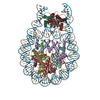 9l22C M: map data used to model this data C: citing same article ( |
|---|---|
| Similar structure data | Similarity search - Function & homology  F&H Search F&H Search |
- Links
Links
- Assembly
Assembly
| Deposited unit | 
|
|---|---|
| 1 |
|
- Components
Components
-Protein , 5 types, 10 molecules AEBFCGDHKL
| #1: Protein | Mass: 15229.787 Da / Num. of mol.: 2 Source method: isolated from a genetically manipulated source Source: (gene. exp.)  Homo sapiens (human) / Gene: H3-3A, H3.3A, H3F3, H3F3A, PP781, H3-3B, H3.3B, H3F3B / Production host: Homo sapiens (human) / Gene: H3-3A, H3.3A, H3F3, H3F3A, PP781, H3-3B, H3.3B, H3F3B / Production host:  #2: Protein | Mass: 11263.231 Da / Num. of mol.: 2 Source method: isolated from a genetically manipulated source Source: (gene. exp.)  Homo sapiens (human) Homo sapiens (human)Gene: H4C1, H4/A, H4FA, HIST1H4A, H4C2, H4/I, H4FI, HIST1H4B, H4C3, H4/G, H4FG, HIST1H4C, H4C4, H4/B, H4FB, HIST1H4D, H4C5, H4/J, H4FJ, HIST1H4E, H4C6, H4/C, H4FC, HIST1H4F, H4C8, H4/H, H4FH, ...Gene: H4C1, H4/A, H4FA, HIST1H4A, H4C2, H4/I, H4FI, HIST1H4B, H4C3, H4/G, H4FG, HIST1H4C, H4C4, H4/B, H4FB, HIST1H4D, H4C5, H4/J, H4FJ, HIST1H4E, H4C6, H4/C, H4FC, HIST1H4F, H4C8, H4/H, H4FH, HIST1H4H, H4C9, H4/M, H4FM, HIST1H4I, H4C11, H4/E, H4FE, HIST1H4J, H4C12, H4/D, H4FD, HIST1H4K, H4C13, H4/K, H4FK, HIST1H4L, H4C14, H4/N, H4F2, H4FN, HIST2H4, HIST2H4A, H4C15, H4/O, H4FO, HIST2H4B, H4C16, H4-16, HIST4H4 Production host:  #3: Protein | Mass: 12925.096 Da / Num. of mol.: 2 Source method: isolated from a genetically manipulated source Source: (gene. exp.)  Homo sapiens (human) / Gene: H2AC4, H2AFM, HIST1H2AB, H2AC8, H2AFA, HIST1H2AE / Production host: Homo sapiens (human) / Gene: H2AC4, H2AFM, HIST1H2AB, H2AC8, H2AFA, HIST1H2AE / Production host:  #4: Protein | Mass: 13804.045 Da / Num. of mol.: 2 Source method: isolated from a genetically manipulated source Source: (gene. exp.)  Homo sapiens (human) / Gene: H2BC11, H2BFR, HIST1H2BJ / Production host: Homo sapiens (human) / Gene: H2BC11, H2BFR, HIST1H2BJ / Production host:  #7: Protein | Mass: 42759.449 Da / Num. of mol.: 2 Source method: isolated from a genetically manipulated source Source: (gene. exp.)  Homo sapiens (human) / Gene: DEK / Production host: Homo sapiens (human) / Gene: DEK / Production host:  |
|---|
-DNA chain , 2 types, 2 molecules IJ
| #5: DNA chain | Mass: 58551.277 Da / Num. of mol.: 1 Source method: isolated from a genetically manipulated source Source: (gene. exp.)  Homo sapiens (human) / Production host: Homo sapiens (human) / Production host:  |
|---|---|
| #6: DNA chain | Mass: 58154.988 Da / Num. of mol.: 1 Source method: isolated from a genetically manipulated source Source: (gene. exp.)  Homo sapiens (human) / Production host: Homo sapiens (human) / Production host:  |
-Non-polymers , 1 types, 2 molecules 
| #8: Chemical |
|---|
-Details
| Has ligand of interest | N |
|---|---|
| Has protein modification | N |
-Experimental details
-Experiment
| Experiment | Method: ELECTRON MICROSCOPY |
|---|---|
| EM experiment | Aggregation state: PARTICLE / 3D reconstruction method: single particle reconstruction |
- Sample preparation
Sample preparation
| Component | Name: hDEK-NCP complex conformation 1 / Type: COMPLEX / Entity ID: #1-#7 / Source: RECOMBINANT |
|---|---|
| Source (natural) | Organism:  Homo sapiens (human) Homo sapiens (human) |
| Source (recombinant) | Organism:  |
| Buffer solution | pH: 7.5 |
| Specimen | Embedding applied: NO / Shadowing applied: NO / Staining applied: NO / Vitrification applied: YES |
| Vitrification | Cryogen name: ETHANE |
- Electron microscopy imaging
Electron microscopy imaging
| Experimental equipment |  Model: Titan Krios / Image courtesy: FEI Company |
|---|---|
| Microscopy | Model: TFS KRIOS |
| Electron gun | Electron source:  FIELD EMISSION GUN / Accelerating voltage: 300 kV / Illumination mode: FLOOD BEAM FIELD EMISSION GUN / Accelerating voltage: 300 kV / Illumination mode: FLOOD BEAM |
| Electron lens | Mode: DARK FIELD / Nominal defocus max: 2500 nm / Nominal defocus min: 1500 nm |
| Image recording | Electron dose: 50 e/Å2 / Detector mode: SUPER-RESOLUTION / Film or detector model: GATAN K2 SUMMIT (4k x 4k) |
- Processing
Processing
| EM software | Name: PHENIX / Category: model refinement |
|---|---|
| CTF correction | Type: NONE |
| 3D reconstruction | Resolution: 2.69 Å / Resolution method: FSC 0.143 CUT-OFF / Num. of particles: 180577 / Num. of class averages: 1 / Symmetry type: POINT |
| Refinement | Highest resolution: 2.69 Å Stereochemistry target values: REAL-SPACE (WEIGHTED MAP SUM AT ATOM CENTERS) |
 Movie
Movie Controller
Controller




 PDBj
PDBj
